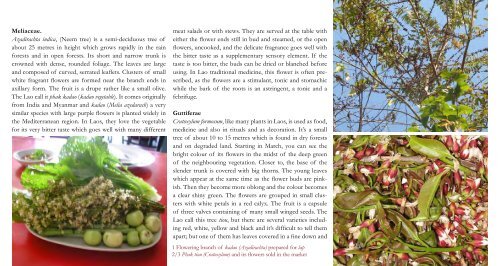You also want an ePaper? Increase the reach of your titles
YUMPU automatically turns print PDFs into web optimized ePapers that Google loves.
Meliaceae.<br />
Azadirachta indica, (Neem tree) is a semi-deciduous tree of<br />
about 25 metres in height which grows rapidly in the rain<br />
forests and in open forests. Its short and narrow trunk is<br />
crowned with dense, rounded foliage. The leaves are large<br />
and composed of curved, serrated leaflets. Clusters of small<br />
white fragrant flowers are formed near the branch ends in<br />
axillary form. The fruit is a drupe rather like a small olive.<br />
The Lao call it phak kadao (kadao vegetable). It comes originally<br />
from India and Myanmar and kadao (Melia azedarach) a very<br />
similar species with large purple flowers is planted widely in<br />
the Mediterranean region. In Laos, they love the vegetable<br />
for its very bitter taste which goes well with many different<br />
meat salads or with stews. They are served at the table with<br />
either the flower ends still in bud and steamed, or the open<br />
flowers, uncooked, and the delicate fragrance goes well with<br />
the bitter taste as a supplementary sensory element. If the<br />
taste is too bitter, the buds can be dried or blanched before<br />
using. In Lao traditional medicine, this flower is often prescribed,<br />
as the flowers are a stimulant, tonic and stomachic<br />
while the bark of the roots is an astringent, a tonic and a<br />
febrifuge.<br />
Guttiferae<br />
Cratoxylum formosum, like many plants in Laos, is used as food,<br />
medicine and also in rituals and as decoration. It’s a small<br />
tree of about 10 to 15 metres which is found in dry forests<br />
and on degraded land. Starting in March, you can see the<br />
bright colour of its flowers in the midst of the deep green<br />
of the neighbouring vegetation. Closer to, the base of the<br />
slender trunk is covered with big thorns. The young leaves<br />
which appear at the same time as the flower buds are pinkish.<br />
Then they become more oblong and the colour becomes<br />
a clear shiny green. The flowers are grouped in small clusters<br />
with white petals in a red calyx. The fruit is a capsule<br />
of three valves containing of many small winged seeds. The<br />
Lao call this tree tiou, but there are several varieties including<br />
red, white, yellow and black and it’s difficult to tell them<br />
apart; but one of them has leaves covered in a fine down and<br />
1 Flowering branch of kadao (Azadirachta) prepared for lap<br />
2/3 <strong>Pha</strong>k tiou (Cratoxylum) and its flowers sold in the market


